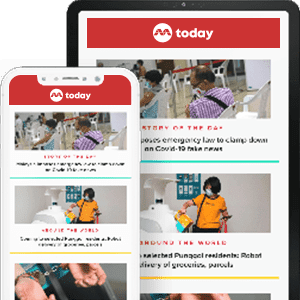Designing and protecting a planet for all species
The circuit breaker earlier this year afforded me time to catch up on my reading and one of the books I found riveting was Ruined By Design by Mike Monteiro. He wrote about how everything we have today has been designed by someone; nothing has come out of nowhere. Our cities are designed, our system of governance and justice are designed, and so is our relationship with the natural environment.

The author says that for every built environment project, designers have more than just the one client — he calls this concept the multiplicity of clients.
The circuit breaker earlier this year afforded me time to catch up on my reading and one of the books I found riveting was Ruined By Design by Mike Monteiro.
He wrote about how everything we have today has been designed by someone; nothing has come out of nowhere.
Our cities are designed, our system of governance and justice are designed, and so is our relationship with the natural environment.
My takeaway was that if things are designed, then they can be re-designed.
When you see that a product or service has a negative impact on humanity, you should then understand when and how it was designed, learn from it, then set out to re-design it for the better.
Placing this in the context of the climate challenges we face today, we can see how the abuse of the natural environment by humans can be traced to the design and invention of tools that changed humanity for better and for worse.
Tools, from the very first piece of stone which was sharpened for use as a weapon, to steam engines, fossil-fuelled power stations, cars and other modes of transport, empowered us to detach from the natural food chain and dominate all other species.
The power, however, got to us, and eventually led us to behave as if we were the only “person in the room”, or the only species on Earth.
WHAT CHOICE WILL YOU MAKE?
The implication is that design is about making choices.
Good design, especially for the built environment and urban planning, can catalyse environmental justice and alleviate the challenges of climate change.
Such designs might not be apparent to the uninitiated but have very far-reaching benefits for our planet.
During the circuit breaker period, we saw how all the environmental metrics pointed (or re-pointed) in the right direction.
The sky was bluer, air pollution levels decreased, and wildlife got bolder and ventured onto our streets. This was apparent outside of Singapore too.
This clearly dispels any doubt that the environmental challenges we have been facing were anthropogenic.
But the clock is ticking and we are running out of time.
This is why I have made combating climate change and threats to biodiversity my main preoccupation as an engineer, educator and designer.
So how then can design be used to create sustainable cities?
I think it is very important to acknowledge that for every built environment project, designers have more than just the one client — I call this concept the multiplicity of clients.
Designers should ask ourselves: Who else will our design impact and who else are we responsible to?
Then take all the answers into account when conceptualising the project.
Every project has a paying client with a site, a brief and a budget.
Of course it is designers' legal, ethical and moral duty to ensure that this client achieves his or her development objectives.
But this is not the only “client” designers have a duty of care towards.
The streets around the site are our “clients”; we have a duty to ensure that they are enhanced after the development is completed.
The neighbours in the surrounding buildings; flora and fauna, and on a much larger scale, even the city, country and planet — these are all our clients whom we owe a duty of care.
Everyone from the old man who walks his dog along the street your site is on, to the tree that grows on it, and even the ladybug that lives on the said tree is a client.
Unlike the paying client, the planet does not have an army of project managers and lawyers to ensure we abide by the contract.
We have to be its champion.
WHAT ARE YOUR ENABLERS?
I acknowledge that it is tough enough to satisfy the requirements of that one client, much less all the others.
Fortunately, in our quest to meet the demands of our multiple clients, designers have technology on our side.
Harnessing the power of technology and integrating it into our design processes will go a long way to achieving environmental responsiveness.
In engineering and design, we have the power of advanced computational design to help us.
It allows us to model a project and build it virtually to identify anything superfluous.
It allows us to be precise with our calculations to prevent wastage and to ensure safety is not compromised. It saves us time.
What used to take three weeks can now be done in three hours, and so the remaining time can be used to refine our work and reduce its embodied carbon footprint, for instance.
Then let us not forget to approach this with a dose of humility — something we are quite lacking at the moment as a species.
Take for instance the continuous rise in atmospheric CO2, melting polar ice caps, disappearing species and deforestation — these are all anthropogenic.
We can counter the effects of deforestation and rapid urbanisation with responsible and sustainable buildings that not just preserve and restore the surrounding habitat, but also produce their own energy, materials, water and more.
This can be achieved with creative design and design thinking.
We have to respect nature as older and wiser than us and learn from it.
The concept of waste does not exist in nature.
A dead bug is food for another animal. The circularity in nature ensures that every output is the input of the next in a closed-loop manner. We can safely say that its processes are much more efficient and effective.
Nature achieves this through being bespoke — in a forest, no two trees are alike, everything is unique.
There is a symphony of colours, shapes, forms and sizes.
The same cannot be said of our built environment, where there is so much ubiquity and almost obsession with standardisation and modularity.
The arrogance of much of our species has led us to do whatever we want to the detriment of our environment.
If there’s one realisation that came out of the lockdowns and “circuit breakers” the world over in 2020, it is that the damage to the environment and threat to biodiversity have clearly been man-made.
The minute we were forced to reduce our business-as-usual activities, all climate indicators pointed in a healthy direction. We have been the real culprits.
This anti-social behaviour is not only wrong and damaging, but also unsustainable. We need to accept that this planet is for all species, not just for us humans.
I hope that all designers, from engineers to architects, urban planners and policy makers and all in the business of creating new objects and policies, act upon this before time really runs out.
Let us make a conscious choice not to ruin Earth with our designs but to leave it greater, better and more beautiful.
ABOUT THE AUTHOR:
Dr Hossein Rezai, a structural engineer by training, is the founding director of engineering firm Web Structures. He was the Designer of the Year in the President's Design Award (P*DA) 2016. He currently serves as the vice-chair of the P*DA 2020 design jury panel.









